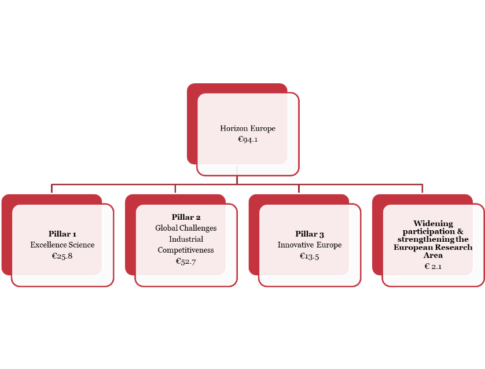The shape of Horizon Europe, the new framework programme on research and innovation from 2021-2027, has been the subject of intense public debates at EU level since the European Commission’s proposal in 2018. With the aims of strengthening the EU’s scientific and technological base, boost Europe’s innovation capacity and competitiveness, create jobs in R&I and address the sustainable development goals, the Commission proposed a budget of around €100 billion euros to be allocated for research and innovation in the upcoming funding period. This would mark a substantial increase from the current framework programme, Horizon 2020 (€ 80 billion). Yet, and despite the budget increase, many argue that Horizon Europe presents an evolution and not a revolution of STI policy in Europe.
Technopolis Group follows closely key aspects of the Horizon Europe developments, be that on programme development (Missions, European Innovation Council, European Partnerships, Open Science, etc), the negotiations processes among the institutions and member states, developments on third country participation and last but not least, budgetary changes.
A partial general agreement between the Commission, the European Parliament and the Member States was reached on the 20th of March 2019. In order for the current proposal to become a general agreement, budgetary aspects and thus the Multiannual Financial Framework (MFF) need to be agreed among the Member States first and foremost. The following budget figures are indicative and based on the EC’s proposal. Obviously, if the budget is increased or decreased, the budgets change as well.
Three-pillar structure remains, but role of industry is increased
Horizon Europe maintains the 3-pillar structure, but the so-called three O’s1 concept is removed. The Pillars for the 2021-2017 framework programme are:
- Pillar I – Excellent Science,
- Pillar II – Global Challenges and European Industrial Competitiveness
- Pillar III – Innovative Europe.

Pillar 1: Excellent Science (€ 25.8 billion) Composed of the European Research Council (ERC), mobility programmes and bursaries (the long-standing Marie Sklodokowska-Curie programme) and research infrastructures, this pillar’s agenda is mainly focussing on individual researchers. It aims to create and diffuse knowledge, strengthen the impact of research to support EU policies, and support (breakthrough) research. One of the longer-term objectives already a key policy under Horizon 2020 is to create a European Open Science Cloud, as a repository of knowledge.
Pillar 2: Global Challenges and European Industrial Competitiveness (€52.7 billion) supports research targeting societal challenges and reinforcing industrial capacities in Europe. This pillar includes the institutionalised European partnerships – large-scale, industry lead consortia which will absorb less than half of the budget – if it goes as the Member States want it. Beside the partnerships, the thematic clusters1 dominate – many of them already in place under H2020.
A novelty of this pillar has been the introduction of Missions – so far, a concept which causes debate among researchers and policy makers alike. Originally planned to channel STI funding to tackle global challenges (such as Alzheimer’s disease, zero-carbon travel etc.), the main questions quickly passed to ‘what missions to chose’ and ‘who decides on the missions’?
Five Mission areas have been agreed to serve as pilots. They include: Climate Change; Cancer; Healthy Oceans; Climate-neutral and smart cities; Food and social health. The design of the Missions are currently in full swing – they are core of the new co-design process the EC embraces. Once decided how they should be implemented, this be then laid down in the Strategic Plan.
Pillar 3: Innovative Europe (€13.5 billion) supports entrepreneurs in launching breakthrough innovation, by attracting scalable companies and encouraging co-investment between public and private investors. The channels of achieving this include the new European Innovation Council (EIC), the European Institute of Innovation and Technology (EIT) and the European innovation ecosystem at large. It is under this pillar that financial support, in forms of grants and guarantees, is provided directly for SMEs. The largest part with €10.5 billion is foreseen for the EIC.
Horizontal activity: Widening participation & strengthening the European Research Area (€2.1 billion)
This horizontal section of Horizon Europe includes two important policy areas. With “Widening participation and spreading excellence” it is acknowledged that more action is needed to address those Member States not well represented in the participation rates of the Framework Programme. “Reforming and Enhancing the European R&I system” has been a key policy priority for two decades, when the European Research Area (ERA) concept was developed. Thus, relevant policies address countries that are lagging in their R&I efforts and infrastructures. Its overall ambition is to share knowledge with those countries and to improve their research and innovation landscape.
Budget & Next steps
The overall Horizon Europe budget as well as its detailed allocation over specific pillars is still subject to change. Despite many efforts from Carlos Moedas, the former Commissioner on Research, Science and Innovation, to push for an agreement prior to the European elections in May 2019, the delayed formal Brexit is one of the main reasons why Member States are still discussing on the Multiannual Financial Framework, which includes also the Horizon Europe (HE) budget. This open question is further linked to the equally open questions on associated countries and the coupling of research funding with other funding streams (ie., EU structural funds).
The European elections in 2019 and the instalment of the new Commission in the same year did not facilitate the negotiation for Horizon Europe. Thus, by mid 2020 there is not yet a general agreement, nor the implementing acts, the Strategic Plan 2021-2024 is still under development and negotiations on the budget are ongoing. This in turn impacts the development of the first work programmes and the negotiation with potentially associated countries. The start of Horizon Europe in January 2021 will likely to be bumpy.
How much money can be expected? Following the Commission’s proposal of €100 billion, the European Parliament proposed an increase of the budget to €120 billion (in 2018 prices). Many argue that such an increase is unrealistic given the fierce negotiations over the MFF. Amid budgetary speculations and divisions, some clarity was thought to have been brought within the launch of the new work programme of the European Commission in December 2019, which states a budget of €98 billion for Horizon Europe demonstrating that the von der Leyen Commission weights a substantial R&I budget as needed in their green and digital transformation objective.
As the Multiannual Financial Framework of the EU enters the last phase of negotiations, with the current MFF ending in December 2020, Europe is currently in the ambit of the Covid19 pandemic, and the attention of the Commission and the Member States is mainly directed toward dealing with the situation. Consequently, all non-essential Parliament and Council meetings have been put on hold and the institutions shifted to digital communication. Clearly, the pandemic and its disastrous economic effects put a lot of pressure on the Member States to agree on a substantial MFF for the next phase. The imminent role of researchers in this pandemic suggests that R&D budgets will play an important role in the future of Europe.





